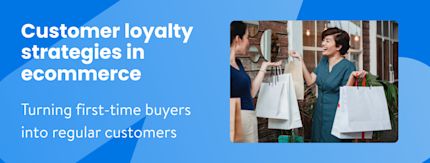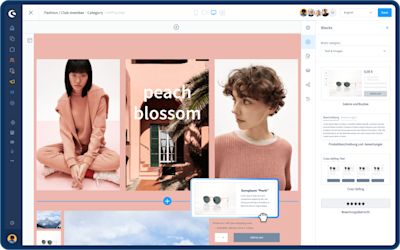
Online shopping is on the increase in both B2B and B2C [1]. But how much is your online shop benefitting from this growth? If your revenue is stagnating, it might be because too many of your customers only make a single purchase. This is problematic as the cost of acquiring new customers has been rising for years [2]. So it's all the more worthwhile to persuade customers who have already been won over to make repeat purchases. Find out here what the most important customer loyalty strategies are for turning one-time customers into regular customers. We have six specific tips for Shopware features and modules you can use to implement these brand loyalty strategies without delay.
What this article is about:
Customer retention vs. new customer acquisition: which is more efficient and cost-effective today?
Measures for your online business to increase the repurchase rate
Here’s how important customer loyalty is in ecommerce
Customer retention is crucial in ecommerce due to the high cost and time investment required for acquiring new customers, especially as advertising costs through Google Analytics, Meta, or LinkedIn continue to rise. Therefore, focusing on existing customers is more important now than ever. Efficiency is more sustainable than growth at any cost, making customer retention a central element in ecommerce. It's also the foundation for increasing Customer Lifetime Value (CLV) and the repurchase rate. However, many online stores do not sufficiently differentiate from competitors and offer too few incentives for customers to make repeat purchases, making it difficult to increase online shop revenues. The solution is to excite your customers on their first visit to your shop.
Success factors in ecommerce: How to strengthen customer retention online, build customer trust, and improve brand loyalty
In online shopping, customers are often critical and reticent. This applies in particular to new customers who don’t know your store. So if you can ensure that your customers trust your online store, are satisfied with their shopping experience, and remain loyal to your brand, you can very easily reactivate inactive customers and motivate first-time buyers to purchase again. That’s how you ensure business success in the long term.
Ensuring good customer relations and creating customer loyalty in ecommerce is more efficient and cost-effective than acquiring new customers
The search for new customers is time-consuming and expensive – unlike customer loyalty measures, which are usually much more efficient. Because with a consistent number of customers who repeatedly purchase in your shop, you can generate high revenue in a short time. Especially in the current economic situation – with decreasing marketing budgets, higher expectations, purchasing reluctance, and rising costs due to inflation or energy prices – it’s important for online retail to save costs in multiple areas. And recontacting first-time purchasers requires less time and money than acquiring new customers. That’s why it makes sense to concentrate on making sure your customers keep coming back regularly.

Ideally, your customer retention strategies ensure that your customers regularly visit your online store.
Experience, look & feel, and loyalty are the top 3 customer retention factors in online stores
Someone who only buys once in an online store may not feel sufficiently connected to the brand or may not be quite satisfied with the online shopping experience. Ideally, the shopping experience should be clear, intuitive, and straightforward.
1. Ecommerce personalization: Give your customer communication a personal touch and stay close to your target group
The more personal your contact with customers, the better. There are lots of opportunities for this along the customer journey. You can confirm orders by email, send invoices with a personal note, or recommend new products to customers and inform them about exclusive offers. You can encourage your customers’ desire to buy with Valentine’s Day, Easter, Black Friday, or Christmas discounts. Keep in touch using emails, newsletters, and updates. This ecommerce customer retention approach encourages occasional and one-time customers to buy from you again.
2. User experience: Make online shopping great again
How do customers experience your online store? Make it as easy as possible for them to order in your online store, with an intuitive product search, rapid loading times, and well-structured navigation. A smooth purchasing process avoids frustration and ensures that online customers go through to complete their order. Payment must be transparent and secure. Customers will only want to return to your store if all processes are consistent and efficient. Think about your store’s look and feel, so that shopping is fun. For example, captivate with interactive features, a mood-enhancing and consistent design, and comprehensive product information in the form of text, images, and videos.

3. Customer loyalty: Reward your customers’ fidelity and increase the repurchase rate
Use customer loyalty programs, such as loyalty points, discount codes, rewards for recommendations, bonuses, promotional gifts, special offers, and lots more. These are a thank you to your customers for always coming back to buy from you. And a positive side-effect is that you’re also encouraging them to buy more. That’s how to build customer trust and loyalty, so that one-time customers become regulars.
Sounds complicated and time-consuming? It doesn’t have to be. It couldn’t be easier to implement these customer retention strategies in B2B or B2C with an ecommerce platform such as Shopware. Here are six tips to improve your online customer loyalty in the blink of an eye.
Tip 1 – Automate your workflows with the Flow Builder: Save time and enhance the shopping experience
Automating processes doesn’t just ensure a consistent user experience for your customers. You also benefit from it as a store operator. By mapping your business processes in Shopware, you can considerably reduce the amount of time you have to put in. You can then use this saved time to communicate with your customers, for instance.
The Flow Builder feature allows you to offer your customers multiple delivery options and payment methods, send a friendly email with their invoice, and much more. This all makes the shopping experience smoother.
You don’t need any programming skills for the Flow Builder:
Go into the settings and create a new flow. First, choose an event that will automatically trigger an action in Shopware.
Then select the required conditions and rules from a dropdown list.
Save your new workflow – and there you are!
Tip 2 – Storytelling in ecommerce with Shopware's Shopping Experiences: Strengthen your brand identity and customer loyalty
Transform your storefront into a shopping experience – and design a themed world for your digital storytelling. Shopping in your store will become a real brand experience.
For the Shopware Shopping Experiences feature, you need no programming knowledge and you don’t need to be a design genius. You simply create your digital storefront using drag & drop. And the best thing is that you can adjust product and category pages so to make your content impressive and authentic. You can also specify when you want to show which content to which target group. With Shopware Shopping Experiences it’s a straightforward matter to improve the customer journey and scroll navigation to create a good look & feel, or to create quick views for your customers.

Tip 3 – Marketing automation as a customer retention strategy: Provide purchase incentives and increase the repurchase rate
Who are the people that buy from you? Creating targeted mail and marketing campaigns to encourage repeat purchasing only works if you know who your customers are. This improves your repurchase rate. And to keep the work involved to a minimum, you should send your email series automatically at the appropriate time.
To create relevant content for each target group, you should first categorize your customers. Shopware’s Flow Builder and Rule Builder help you do this using specific criteria, such as purchasing history, preferences, behavior, or demographic information. With these tags, you can then send emails to particular customer groups. You can create and send a regular newsletter using the newsletter module in Shopware’s administration.
Tip 4 – Reward customer loyalty with the promotions module: Set incentives and deepen customer engagement
Use the information you have about your one-time customers to send personalized emails and notifications. You can recommend articles to them or offer a discount to mark special occasions such as birthdays.
Shopware’s promotion module can help you set up discount campaigns for product groups or create promotion codes, for example. Here, too, you first specify an event that triggers customers’ eligibility for a discount, for instance when they put products in their shopping cart that qualify for a discount, or when they reach a certain goods value. You can also specify the period of time when a discount can be used, or how often customers can benefit from a discount campaign.
Tip 5 – Automate orders with the "Subscriptions" feature: Increase customer lifetime value and generate continuous revenue
A subscription function is particularly useful for consumable goods such as food, beverages, pet food, personal care products, cosmetics, cleaning supplies, magazines, and similar items. This way, customers don't have to reorder the same product in your online shop constantly. Consumable products are then regularly and conveniently shipped to your customers' homes. This additional service boosts your customers' satisfaction –and the Customer Lifetime Value.
The Subscription feature allows you to automate orders for subscription-based products very easily. You can even specify that your customers can manage their subscriptions themselves, or that you can apply discounts to subscription articles.

Tip 6 – Increase the average order value with cross-selling and up-selling
Use cross- and up-selling options, too, to inspire your customers to make more purchases. This way, you can specifically increase the average order value by offering your customers suitable or higher-quality products: For example, you can offer similar items in the online shop if the desired product is no longer available. Or when you send an email, suggest other products in addition to those already purchased. This not only improves the user experience, but also increases the number of articles in the customer’s shopping cart or the likelihood of an additional order.
You can easily learn how to set up products for cross-selling in Shopware 6 by reading the appropriate section of the Shopware user documentation.
Conclusion: Elevate your customer loyalty game with Shopware
As demonstrated, prioritizing customer loyalty is not just beneficial—it's essential. It's the key to unlocking consistent profits from customers who look forward to returning to your store. This article has explored a variety of strategies, from leveraging content and commerce to crafting personalized offers and embracing subscription models, all aimed at fostering a loyal customer base for your brand.
Interested in boosting customer loyalty with maximum efficiency? The golden trio for e-commerce success involves enhancing the user experience, deploying marketing automation, and implementing clever loyalty programs. Shopware's features and modules are perfectly designed to help you master these measures.
Not on Shopware yet?
Discover the power of Shopware to captivate your online shoppers, making them eager to return. Whether you're focusing on perfecting the user experience or utilizing practical, efficient features, Shopware is your go-to solution. Keen to dive deeper into how Shopware can help you cultivate a loyal customer base? We would be happy to advise you in a personal conversation.
Sources:
[1] https://www.statista.com/statistics/454371/e-commerce-revenue-germany/









